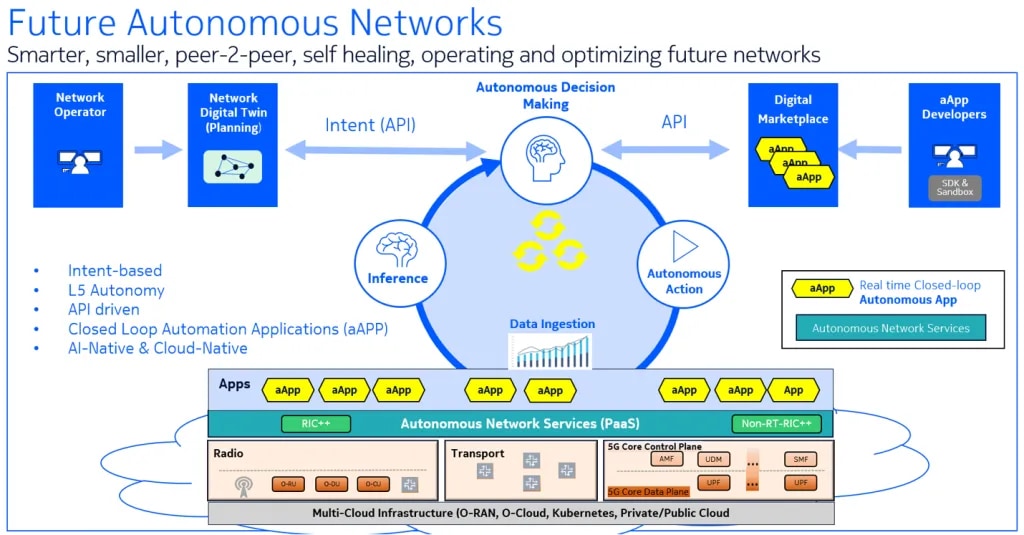A real-world application lens to agentic autonomous networks

The telecom landscape is undergoing a dramatic transformation, driven by the convergence of 5G and 5G advanced, accelerated adoption of AI- and cloud-native architectures and eventually emergence of 6G. This convergence is creating unprecedented demands on multi-domain network infrastructure, requiring a paradigm shift toward more intelligent, adaptable and self-sufficient networks. Enter the concept of agentic autonomous networks, a vision where networks can self-heal, self-optimize and self-operate, freeing up human operators to focus on higher-level tasks.
This paper presents a framework for self-aware and self-organized multi-domain networks. It explores pragmatic, real-world applications that highlight the need for localized agentic autonomous decision-making applications to execute this framework.
The challenges of today's CSPs networks
Traditional networks are multi-vendor and multi-domain, with enormous complexity. They are often characterized by manual configuration, reactive troubleshooting and limited automation. This leads to several challenges:
- Operational complexity leading to slow or no self-decision-making: It’s a daunting task to manage a cross-domain/vendor network with multiple touchpoints, conflicting policies, configurations and resource constraints. Manual intervention and limited automation lead to slow responses to network events (weeks to months), impacting user experience and service quality.
- Lack of simple programmable interfaces: Applications and AI systems struggle to communicate their needs to the network in a clear and programmable manner, especially via simplified and well-defined, intent-based APIs.
- Limited AI-native designs in networks today: Networks lack a) observability interfaces (real-time/non-real time) b) the ability to learn from mistakes (think Gen AI model farms) and c) proactively adapt to changing conditions and address issues.
The promise of agentic autonomous networks for CSPs
Autonomous networks aim to address these challenges by leveraging AI, automation and cloudification to create self-aware, self-healing and self-optimizing systems that constantly learn. Key features of autonomous networks include:
- Intent-based operations: Networks are configured and managed based on high-level intents, such as “ensure low latency for gaming applications,” “maximize throughput for industrial applications” or, at the lower level, “configure a slice for X bandwidth, Y jitter and Z latency.” Consumer, industrial and emergency services will increasingly drive these intents, and we are seeing these use cases unfolding in advanced markets.
- AI-native decision-making: AI native frameworks observe network real- and non-real-time data, identify patterns and make real-time decisions to act, optimize performance, thereby proactively address potential issues and adapt to changing conditions.
- Closed-loop automation: Localized autonomous applications (aApps) monitor network performance, detect anomalies and trigger corrective actions without human intervention. These aApps — related to different resources and services — talk natively (via intents) to each other in an agentic way to resolve situations locally.
- Service level self-healing, self-learning capabilities: This refers to multi-domain networks that can automatically identify and resolve issues such as congestion, network failures and security threats. Networks are constantly learning about the status, event, prediction, decision and actions taken, and they use that information for future decision-making and actions.
- Dynamic resource allocation: AI native designs dynamically adjust resource allocation based on real-time network conditions, ensuring optimal performance and minimizing service disruptions.
A new generation of self-aware, self-managing networks – localized agentic automation & decision making
To realize the vision of agentic autonomous networks, we must leverage AI- and cloud-native technologies, as well as localized decision AI native agents (aApps) to create a new generation of self-aware and self-managing networks. Key components include:
- Introducing aApps (localized agentic autonomous applications): These specialized micro applications manage specific network resources, services or functions, with a closed-loop operation that can be defined by a no-code or code manner. They are typically deployed very close to the network nodes (edge/regional or central) and can predict, decide and act on behalf of a resource, service or even a business objective. An example of a closed-loop operation is: “If a congestion happened in this resource, make a decision (e.g., reroute traffic to this destination) or do resource allocation (scale up) …”
- Intent-based configuration: Networks and services are configured based on high-level intents, allowing for simplified management and automation by hierarchical framework of agentic aApps.
- Multimodal decision-making: This is accomplished through a combination of machine and reinforcement learning, large language models (LLMs), casual analyzers and rule-based systems for prediction that enables intelligent decision-making. aApps augmented with verticalized trained models enables such decision making.
This all leads to Autonomous network services. These services provide the core functionality for self-healing, self-optimization and self-protection at the edge. They are the platform services that allow any system to be autonomous.

The role of AI in autonomous networks
AI plays a critical role in enabling autonomous networks by:
- Data analysis and pattern recognition: AI (ML and LLM) systems analyze vast amounts of network data to identify patterns, trends and anomalies. Unstructured and structured data are simultaneously processed with different model systems in cohesive way to drive even more complex decisions.
- Predictive modeling: AI Ops can predict future network behavior, allowing for proactive optimization and issue prevention.
- Decision-making and automation: AI systems can make real-time decisions to optimize network performance, address issues and adapt to changing conditions.
- Continuous learning and improvement: AI models can learn from past experiences and adapt to evolving network conditions, continuously improving their performance.
Real-world applications for Communications Service Providers
Building on our domain expertise — bundled with the unique knowledge base of cloud- and AI-native technologies across our portfolio — cross-domain potential use cases for autonomous networks include:
1. Traffic routing and congestion management-Scenario: An autonomous network edge experiences congestion in a specific area due to a surge in traffic from a popular video streaming service.
Autonomous network action: An autonomous application (aApp) monitors network and cloud service & resource performance, detects congestion and triggers a series of actions based on real-time data:
-
Traffic rerouting: The aApp reroutes traffic to less congested paths, leveraging pre-configured fallback routes.
-
Dynamic bandwidth allocation: The aApp adjusts bandwidth allocation to prioritize critical services and ensure smooth operation.
-
Scaling up resources: The aApp triggers the deployment of additional network resources (e.g., UPFs) in the congested area to handle the increased load.
2. Self-healing and fault tolerance - Scenario: A network component (e.g., base station, core network application, optical and transport subsystem) fails, disrupting service for users in a particular area.
Autonomous network action: A localized agentic aApp detects the failure and triggers a series of actions:
-
Fault isolation: The aApp predicts potential future faults and identifies the network’s affected resources.
-
Service restoration: The aApp automatically reroutes traffic to alternative paths, minimizing service disruption.
-
Resource provisioning: The aApp triggers the deployment of replacement resources to restore full network functionality.
3. Dynamic resource allocation and optimization - Scenario: A network experiences fluctuating traffic patterns throughout the day, with peak demands during specific hours.
Autonomous network action: An aApp monitors traffic patterns and dynamically adjusts resource allocation:
- Dynamic slice allocation: The aApp allocates network resources (e.g., bandwidth, compute power) to different slices based on real-time traffic demands and historic patterns.
- Workload placement: The aApp dynamically moves workloads (e.g., XR applications) between edge clouds to optimize performance and minimize latency.
- Self-scaling: The aApp automatically scales network resources, up or down, based on traffic fluctuations, ensuring optimal performance and cost efficiency.
4. Security threat detection and mitigation - Scenario: A network predicts or detects a potential security threat, such as a denial-of-service attack or malware intrusion.
Autonomous network action: An aApp analyzes network traffic, identifies suspicious patterns and triggers actions:
- Threat isolation: The aApp isolates the affected network segment to prevent the threat spreading.
- Security policy enforcement: The aApp dynamically adjusts security policies to mitigate the threat.
- Threat response: The aApp triggers automated responses, such as blocking malicious traffic or quarantining infected devices.
5. Personalized service delivery- Scenario: An application developer requests a specific service with customized requirements (e.g., low latency for gaming, high bandwidth for video streaming).
Autonomous network action: An aApp analyzes the user's request and dynamically configures the network to meet their application needs through:
- Slice customization: The aApp creates a customized network slice with specific QoS parameters.
- Resource allocation: The aApp allocates network resources (e.g., bandwidth or compute power) to the user's slice to ensure optimal performance.
- Service optimization: The aApp continuously monitors the user's experience and adjusts network settings to optimize performance and minimize latency.
These are just a few examples of potential use cases for autonomous networks. As AI native autonomous decision-making continue to advance, we can expect to see even more innovative applications emerge, transforming the way we design, manage and experience telecommunications networks.
Conclusion
The dawn of autonomous networks is upon us, driven by the convergence with 5G, 5G Advanced and AI. As a next step, we must leverage AI- and cloud-native-based automation to create self-aware, self-healing and self-optimizing networks. As these technologies mature, we can expect to see a dramatic transformation in the telecom landscape, with networks becoming more intelligent, adaptable and efficient, ultimately delivering a better experience for users.
